
 Google has today announced ‘Favorite Places’, a new project to bring its searches into the real world using QR Codes.
Google has today announced ‘Favorite Places’, a new project to bring its searches into the real world using QR Codes.
In case they’ve passed you by, QR Codes are square barcodes which, when photographed by a mobile phone camera, lead the phone’s browser to a particular web page.
Google is sending a unique QR code to over 100,000 of its most searched-for businesses across the USA. These can be displayed in the window of each business. When scanned, it leads to that business’ Google Places page and presents user generated reviews, plus special offers if the business is running any. In future reviews for the that business will be able to be left direct from the mobile interface.
Will Google get us all using QR Codes?
QR Codes are immensely popular in certain parts of the world, most notably Japan where they often feature in print and TV advertising. They’re a quick and convenient way of driving traffic to your site – if the audience is accustomed to them.
Much of the western world has been slow to adopt the technology. Although some big-name brands have tried the idea (Pepsi recently ran a mobile-focused campaign in the UK that used QR Codes to drive traffic, for example), in general most advertising continues to rely on traditional URLs.
There’s no doubt that Google’s move will see an increase in the US public’s exposure to QR codes and Google is almost certain to roll this scheme out to other countries. So, that sets us up for a QR Code-dominated future, right? Maybe not.
The barrier to acceptance
If you’re not used to them, QR codes are fiddly to adjust to. You need a QR Code reading app installed on your phone. Although many phones come with this built in, it’s usually hidden away within the darkest recesses of the menu structure. Once you’ve found your QR reader, you have to get your phone out, open the QR reader app, scan the code, wait for it to be read, wait for your browser to load and finally you get to access the site.
For now, QR Codes still need an explanation of what they are and how they’re used whenever they’re displayed. In many cases it would be quicker to just type in the URL. Marketers need to get the attention of their audience quickly. For now it’s still easier to give them a snappy, memorable URL that users can go to when they’re ready.
Google’s move today will certainly do a lot to raise the profile of QR Codes in the West. However, what’s really needed is a truly mainstream campaign educating the public on how to use QR Codes. For smartphone users accustomed to downloading apps it’s no real hurdle to install a QR reader. For the ‘dumbphone’-owning masses (who often have QR code readers without knowing it), phone UI designers need to bring the capability up to the front of the interface so it becomes an easy to access part of the user’s daily routine.
So, Google’s push into QR Codes is a nudge on the way to greater acceptance of this method of accessing websites but we’re going to need to see a much wider push if the little square barcodes are to become the marketing force they are in Japan.
Get the TNW newsletter
Get the most important tech news in your inbox each week.




